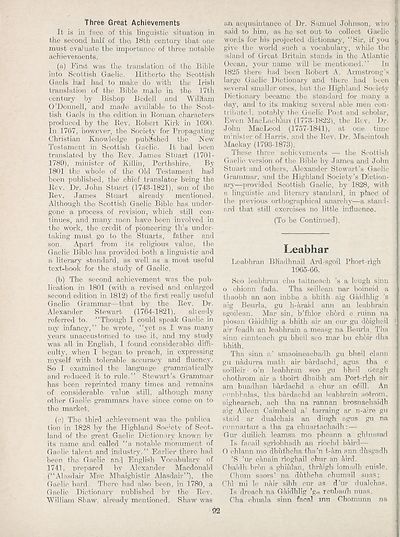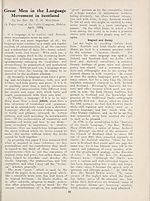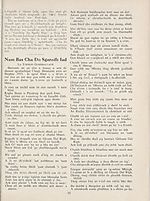An Comunn Gàidhealach Publications > Gaidheal > Volumes 58--62(part), January, 1963--March 1967
(728) Page 92
Download files
Complete book:
Individual page:
Thumbnail gallery: Grid view | List view

Three Great Achievements
It is in face of this linguistic situation in
the second, half of the) 18th century that one
must evaluate the importance of three notable
achievements.
(a) First was the translation of the Bible
into Scottish Gaelic. Hitherto the Scottish
Gaels had had to make do with the Irish
translation of the Bible male in the 17th
century by Bishop Bedell and William
O’Domiell, and made available to the Scot¬
tish Gaels in the edition in Roman, characters
produced by the Rev. Robert Kirk in 1690.
In 1767, however, the Society for Propagating
Christian Knowledge published the New
Testament in Scottish Gaelic. It had been
translated by the Rev. James Stuart (1701-
1789), minister of Killin, Perthshire. By
1801 the whole of the Old Testament had
been published, the chief translator being the
Rev. Dr. John Stuart (1743-1821), son of the
Rev. James Stuart already mentioned.
Although the Scottish Gaelic Bible has under¬
gone a process, of revision, which still con¬
tinues, and many men have been involved in
the work, the credit of pioneering th’s under¬
taking must go to the Stuarts, father and
son. Apart from its religious value, the
Gaelic Biblel has provided both, a linguistic and
a literary standard, as well as a most useful
text-book for the study of Gaelic.
(b) The second achievement was the pub¬
lication in 1801 (with a revised and enlarged
second edition in 1812) of the first really useful
Gaelic Grammar—that by the Rev. Dr.
Alexander Stewart (1764-1821), already
referred to. “Though I could speak Gaelic in
my infancy,’’ he wrote, “yet as 1 was many
years unaccustomed to use- it, and my study
was all in English, I found considerable! diffi¬
culty, when I began to preach, in expressing
myself with tolerable accuracy and fluency.
So I examined the language grammatically
and reduced it to rule.’’ Stewart’s Grammar
has been reprinted many times and remains
of considerable value still, although many
other Gaelic grammars have since comei on to
the market.
(c) The third achievement was the publica
tion in 1828 by the Highland Society of Scot¬
land of the great Gaelic Dictionary known by
its name and called “a notable monument of
Gaelic talent and industry.’’ Earlier there had
been the Gaelic and English Vocabulary of
1741, prepared by Alexander Macdonald
(“Alasdair Mae Mhaighistir Alasdair’’), the
Gaelic bard. There had also been, in 1780, a
Gaelic Dictionary published bv the Rev.
William Shaw, already mentioned. Shaw was
92
an acquaintance of Dr. Samuel Johnson, who
said to him, as he set out to collect Gaelic
words for his projected dictionary, “Sir, if you
give the world such a vocabulary, while the
island of Great Britain stands in the Atlantic
Ocean, your name will be mentioned.” In
1825 there had been Robert A. Armstrong’s,
large Gaelic Dictionary and there had been
several smaller ones, but the Highland Society
Dictionary became the standard for many a
day, and to its making several able men con¬
tribute-1. notably the Gaelic Poet and scholar,
Ewen Mac La,chian (1773-1822), the Rev. Dr.
John MacLeod (1757-1841), at one time
minister of Harris, and the Rev. Dr. Macintosh
Mackay (1793-1873).
These three achievements — the Scottish
Gaelic version of the Bible by James and John
Stuart and others, Alexander Stewart’s Gaelic
Grammar, and the Highland Society’s Diction-
ary—provided Scottish Gaelic, by 1828, with
a linguistic and literary standard, in place! of
the previous orthographical anarchy—a stand¬
ard that still exercises no little influence.
(To be Continued).
Leabhar
Leabhran BMadhnail Ard-sgoil Phort-righ
1965-66.
Seo leabhran cho taitneach ’s a leugh sinn
o chionn fada. Tha seillean nar boineid a
thaobh an aon inbhe a bhith aig Gaidhlig ’s
aig Beurla, gu h-araid ann an leabhrain
sgoilean. Mar sin, b’fhlor chbrd e ruinn na
piosan Gaidhlig a bhith air an cur gu dbigheil
air feadh an leabhrain a measg na Beurla. Tha
sinn cinnteach gu bheil seo mar bu choir dha
bhith.
Tha sinn a’ smaoineachadh gu bheil clann
gu nadurra math, air bardachd, agus tha e
soilleir- o’n leabhran seo gu bheil deagh
chothrom air a thoirt dhaibh am Port-righ air
am buadhan bardachd a chur an c^ill. An
ronbhalas, tha, bardachd an leabhrain aotrom,
aighearach, ach tha na rannan brosnachaidh
aig Ailean Caimbeul a’ tarraing a,r n-aire gu
staid ar dualchais an diugh agus gu na
cunnartara a tha ga chuartachadh:—-
Gur duilich leams'a mo pheann a ghluasad
Is facail sgriobhadh an riochd baird—
0 chlann mo dhuthcha tha’n t-am ann dusgadh
’S ’ur chnain rioghail chur an aird.
Chaidh brbn a ghiid'an, thrkigh iomadh enisle.
Chum saors’ na duthcha chumail suas;
Chi mi le nair sibh cur as d’ur dualchas,
Is dre-ach na. Gaidhlig ’gt, reubadh nuas.
Cha chuala sinn fa,cal mu Chomunn na
It is in face of this linguistic situation in
the second, half of the) 18th century that one
must evaluate the importance of three notable
achievements.
(a) First was the translation of the Bible
into Scottish Gaelic. Hitherto the Scottish
Gaels had had to make do with the Irish
translation of the Bible male in the 17th
century by Bishop Bedell and William
O’Domiell, and made available to the Scot¬
tish Gaels in the edition in Roman, characters
produced by the Rev. Robert Kirk in 1690.
In 1767, however, the Society for Propagating
Christian Knowledge published the New
Testament in Scottish Gaelic. It had been
translated by the Rev. James Stuart (1701-
1789), minister of Killin, Perthshire. By
1801 the whole of the Old Testament had
been published, the chief translator being the
Rev. Dr. John Stuart (1743-1821), son of the
Rev. James Stuart already mentioned.
Although the Scottish Gaelic Bible has under¬
gone a process, of revision, which still con¬
tinues, and many men have been involved in
the work, the credit of pioneering th’s under¬
taking must go to the Stuarts, father and
son. Apart from its religious value, the
Gaelic Biblel has provided both, a linguistic and
a literary standard, as well as a most useful
text-book for the study of Gaelic.
(b) The second achievement was the pub¬
lication in 1801 (with a revised and enlarged
second edition in 1812) of the first really useful
Gaelic Grammar—that by the Rev. Dr.
Alexander Stewart (1764-1821), already
referred to. “Though I could speak Gaelic in
my infancy,’’ he wrote, “yet as 1 was many
years unaccustomed to use- it, and my study
was all in English, I found considerable! diffi¬
culty, when I began to preach, in expressing
myself with tolerable accuracy and fluency.
So I examined the language grammatically
and reduced it to rule.’’ Stewart’s Grammar
has been reprinted many times and remains
of considerable value still, although many
other Gaelic grammars have since comei on to
the market.
(c) The third achievement was the publica
tion in 1828 by the Highland Society of Scot¬
land of the great Gaelic Dictionary known by
its name and called “a notable monument of
Gaelic talent and industry.’’ Earlier there had
been the Gaelic and English Vocabulary of
1741, prepared by Alexander Macdonald
(“Alasdair Mae Mhaighistir Alasdair’’), the
Gaelic bard. There had also been, in 1780, a
Gaelic Dictionary published bv the Rev.
William Shaw, already mentioned. Shaw was
92
an acquaintance of Dr. Samuel Johnson, who
said to him, as he set out to collect Gaelic
words for his projected dictionary, “Sir, if you
give the world such a vocabulary, while the
island of Great Britain stands in the Atlantic
Ocean, your name will be mentioned.” In
1825 there had been Robert A. Armstrong’s,
large Gaelic Dictionary and there had been
several smaller ones, but the Highland Society
Dictionary became the standard for many a
day, and to its making several able men con¬
tribute-1. notably the Gaelic Poet and scholar,
Ewen Mac La,chian (1773-1822), the Rev. Dr.
John MacLeod (1757-1841), at one time
minister of Harris, and the Rev. Dr. Macintosh
Mackay (1793-1873).
These three achievements — the Scottish
Gaelic version of the Bible by James and John
Stuart and others, Alexander Stewart’s Gaelic
Grammar, and the Highland Society’s Diction-
ary—provided Scottish Gaelic, by 1828, with
a linguistic and literary standard, in place! of
the previous orthographical anarchy—a stand¬
ard that still exercises no little influence.
(To be Continued).
Leabhar
Leabhran BMadhnail Ard-sgoil Phort-righ
1965-66.
Seo leabhran cho taitneach ’s a leugh sinn
o chionn fada. Tha seillean nar boineid a
thaobh an aon inbhe a bhith aig Gaidhlig ’s
aig Beurla, gu h-araid ann an leabhrain
sgoilean. Mar sin, b’fhlor chbrd e ruinn na
piosan Gaidhlig a bhith air an cur gu dbigheil
air feadh an leabhrain a measg na Beurla. Tha
sinn cinnteach gu bheil seo mar bu choir dha
bhith.
Tha sinn a’ smaoineachadh gu bheil clann
gu nadurra math, air bardachd, agus tha e
soilleir- o’n leabhran seo gu bheil deagh
chothrom air a thoirt dhaibh am Port-righ air
am buadhan bardachd a chur an c^ill. An
ronbhalas, tha, bardachd an leabhrain aotrom,
aighearach, ach tha na rannan brosnachaidh
aig Ailean Caimbeul a’ tarraing a,r n-aire gu
staid ar dualchais an diugh agus gu na
cunnartara a tha ga chuartachadh:—-
Gur duilich leams'a mo pheann a ghluasad
Is facail sgriobhadh an riochd baird—
0 chlann mo dhuthcha tha’n t-am ann dusgadh
’S ’ur chnain rioghail chur an aird.
Chaidh brbn a ghiid'an, thrkigh iomadh enisle.
Chum saors’ na duthcha chumail suas;
Chi mi le nair sibh cur as d’ur dualchas,
Is dre-ach na. Gaidhlig ’gt, reubadh nuas.
Cha chuala sinn fa,cal mu Chomunn na
Set display mode to:
![]() Universal Viewer |
Universal Viewer | ![]() Mirador |
Large image | Transcription
Mirador |
Large image | Transcription
| An Comunn Gàidhealach > An Comunn Gàidhealach Publications > Gaidheal > Volumes 58--62(part), January, 1963--March 1967 > (728) Page 92 |
|---|
| Permanent URL | https://digital.nls.uk/127157517 |
|---|
| Description | This contains items published by An Comunn, which are not specifically Mòd-related. It includes journals, annual reports and corporate documents, policy statements, educational resources and published plays and literature. It is arranged alphabetically by title. |
|---|
| Description | A collection of over 400 items published by An Comunn Gàidhealach, the organisation which promotes Gaelic language and culture and organises the Royal National Mòd. Dating from 1891 up to the present day, the collection includes journals and newspapers, annual reports, educational materials, national Mòd programmes, published Mòd literature and music. |
|---|---|
| Additional NLS resources: |
|

